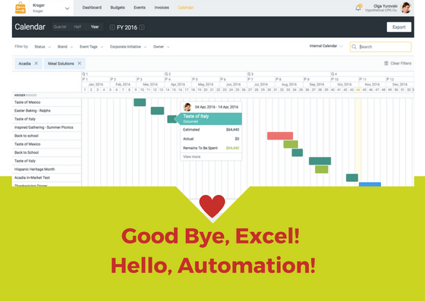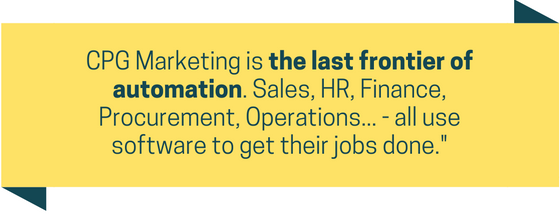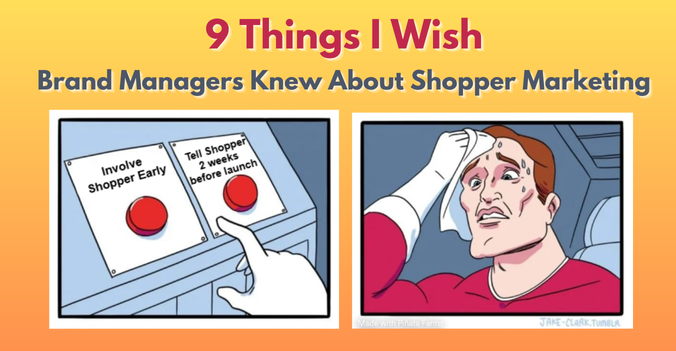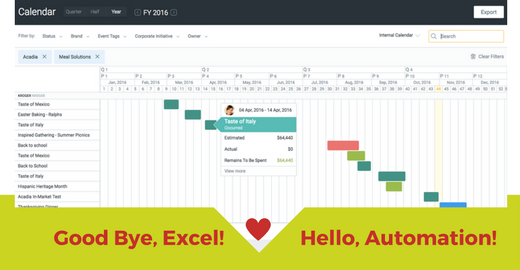 It's 4 pm on a Friday afternoon, and your boss just surprised you with a request to prepare for a Monday afternoon review with a VP of Brand X. Do you have the Brand X shopper marketing plans handy — By retailer? By period? Which promotions are sold in and which ones are still 'soft'? How are you supporting Brand X's new product launch next quarter? Brand X is one of the biggest contributors to your shopper marketing budget, and they deserve to know it all.
It's 4 pm on a Friday afternoon, and your boss just surprised you with a request to prepare for a Monday afternoon review with a VP of Brand X. Do you have the Brand X shopper marketing plans handy — By retailer? By period? Which promotions are sold in and which ones are still 'soft'? How are you supporting Brand X's new product launch next quarter? Brand X is one of the biggest contributors to your shopper marketing budget, and they deserve to know it all.
It's the annual planning season, one of the busiest times, but you are almost done and getting ready to submit your plans to headquarters. Your retail client's merchandising lead just called you and your sales team in for a planning meeting to get your commitments to fund their new personalized direct marketing campaign, holding your entire sales plan hostage. Can you even afford it? How will it be funded? How will it interfere with other promotions you had planned? How fast can you re-build your entire year's worth of assumptions?
The Pressure Is On
If you have worked or are working in the shopper marketing industry lately, you most likely have experienced the anxiety, the frustration and the burnout from these type of ad-hoc requests. They seem to take you and your team by surprise. They cause a lot of late working hours, and they always involve manual sifting through myriad of spreadsheets, copying, pasting, reconciling, double-checking and emailing attachments back and forth between team members.
The troubling part is that these sort of ad-hoc requests are not going to cease any time soon. The more funds and resources shopper marketers receive from management, the more scrutiny and pressureto be transparent they can expect. Retail partners' demands to support their key initiatives and surprising new priorities will only increase with time due to the power shift in favor of retail and the rapid growth of new technologies that are revolutionizing the retail industry. According to Shopperations' research, 49% of shopper marketers' time today is spent on non-value added, back-office activities, such as alignment meetings and conference calls, manual reporting and redundant file management.
The Mindset Shift
What can you do to anticipate these non-stop requests and alleviate the burden of manual reporting and inevitable non-stop replanning? In our view, it requires the shopper marketing leader to stop thinking of their function as pure art form and start treating it more like a science. Art is inherently unpredictable, fickle, messy and relies on inspiration. Science, on the other hand, relies on methods, rules, data and iterative improvements. It is time to marry these two concepts together through the use of automated planning technology.
This mindset shift to a data-driven, automated process has been occurring for quite some time for marketers outside of CPG as well as in many other, non-marketing functions. In fact, the CPG marketing domain appears to be the last frontier of automation. Look around: Sales team have Trade Promotion Management software, HR, Procurement, Finance, Supply Chain and Operations have their own systems or ERP add-ons as well. There is abundant evidence that such technologies save between 20% and 40% of employees' time, build transparency and cross-functional trust, expedite decision making and aid knowledge transfer.

In Search For A Solution
After you realize that your team outgrew Excel, the search for a replacement solution may take you on different paths. Some shopper marketing leaders go for a custom-built, proprietary system, others look for solutions from their agency partners, yet others search for existing off-the-shelf software that can be configured to meet their needs. When evaluating your options, keep in mind the following watch-outs, which will impact the success of the deployment:
1. New system must replace (nearly) all reports and shadow trackers that your team likely uses today. If this new system becomes yet another place for the team to enter the same data into, it will create more work and defeat its purpose. Study all currently used trackers meticulously, question what data is tracked, why it gets captured and whether it is essential to have same data points in the new system.
2. Don't "boil the ocean". Often times, with best intention in mind, teams attempt to build a "perfect shopper marketing tool" that will integrate with multiple systems, answer every possible business question and satisfy all stakeholders. While integration with other enterprise systems can be considered an ultimate goal and therefore factored into the software architecture design, it can and should be implemented in later releases, after initial organizational learning curve and user adoption curve are mastered.
3. Look for more than a "better budget tracker". While budget stewardship is the biggest need and the most acute pain point for shopper marketers, other collaboration and automation features, such as calendars, discussions, artwork file sharing and notifications will make the system more desirable for end users, increase adoption and save even more time by reducing reliance on email.
Has your team started the exciting journey to standardize and streamline your shopper marketing operations? What features would you consider most useful in a marketing system of record? What would you do with all that freed team capacity that such system promises?









